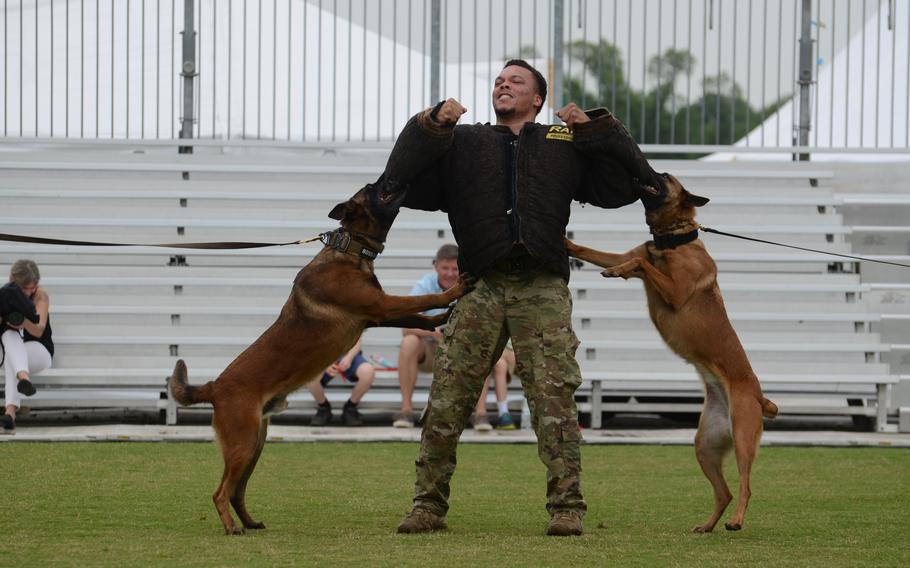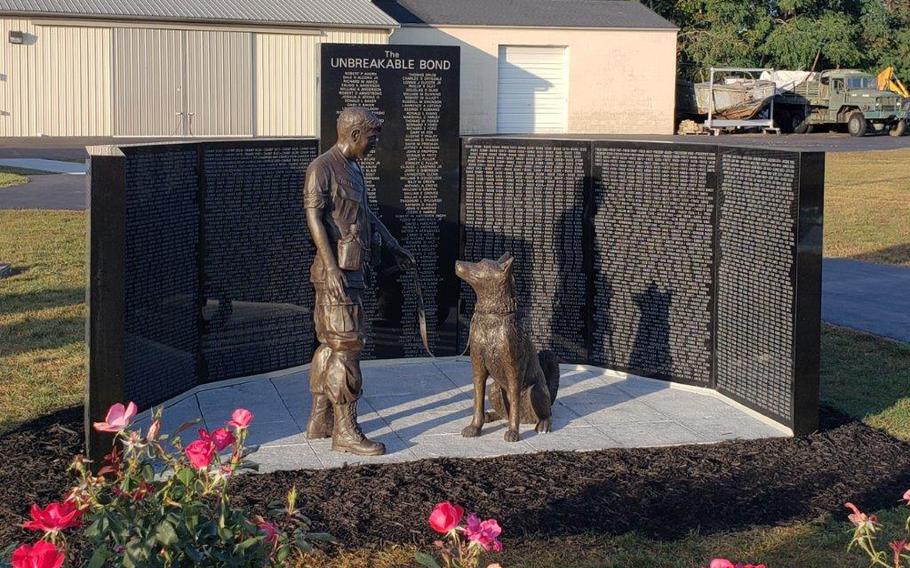
Ed Reeves, a former Army scout dog handler, standing next to a photo from 1971 of him and his dog, Prince. Reeves, 72, was with the Vietnam Dog Handlers Association on May 12, 2023, attending the three-day “Welcome Home” event in Washington, D.C., for Vietnam veterans on the 50th anniversary of the war ending. (Matthew Adams/Stars and Stripes)
WASHINGTON — Army veteran Ed Reeves knows his name could be on the Vietnam Veterans Memorial if it hadn’t been for his German shepherd Prince.
It was Feb. 14, 1971 — Valentine’s Day — Reeves and Prince were a scout team scoping out a trail in Phu Bai, Vietnam, as a group of U.S. soldiers followed behind. A small tree had fallen on the path, but Prince went around it instead of jumping over it. Reeves tried to get the dog to come back but Prince kept circling around the area. Reeves said he could not figure out what the dog was doing so he tried to walk over the tree. Prince came underneath him and put his nose to the ground to indicate something was there.
“I took a step back and he looked at me like, ‘There you go, stupid,’” said Reeves, 72. The dog had discovered a mine was hidden at the spot.
More than 4,000 dogs were trained for scouting, tracking, sentry duty, mine/tunnel detection and water patrols during the Vietnam War. The dogs are believed to have prevented about 10,000 service members from dying, according to the Vietnam Veterans Memorial Fund, the nonprofit organization that built the wall.
But to the military, the efforts of the dogs were not a factor when it was time to come home. Some service members tried to get their dogs back to the U.S., but only 204 dogs returned from Vietnam — 2,000 were euthanized.
Few people attending a three-day “Welcome Home” commemoration in the nation’s capital to honor Vietnam veterans and mark the 50th anniversary of the war’s end knew about the dogs that served in Vietnam. Many of them at the event who passed by a tent set up by the Vietnam Veterans Dog Handler Association made similar comments: “I had no idea about dogs in Vietnam” and “Did we really leave dogs there?”
Joe Gilleran was a sentry and a dog handler in the Army in Ban Me Thuot, Vietnam, in 1970-71. As a sentry, he monitored areas that contained ammunition and fuel, and he conducted perimeter sweeps and base security.
Gilleran volunteered for the service in Scranton, Pa., in 1970 after a couple of guys from his block were drafted and died.
“I didn’t think it was right that some people had to go while others did not,” he said.
It took him a while to find the right job in the Army, but Gilleran was happy when he became a dog handler. He said his German shepherd, Rex, was the best-looking dog in Vietnam, but doesn’t know what happened to the dog after the war. Gilleran, 72, said he assumes the worst.
He also said there could be a few reasons why the military did not bring dogs home from the war.

Military working dogs Boss, left, and Limra, right, work on attack training with Staff Sgt. De’Quan Roland-Hoover. The Military Working Dog unit of the 316 Security Group from Joint Base Andrews, Md., gave a demonstration on the final day of the “Welcome Home” event in Washington, D.C., for Vietnam veterans, marking the 50th anniversary of the war ending. (Matthew Adams/Stars and Stripes)
“It was Uncle Sam being Uncle Sam. Sorry, honey, we don’t have the money,” Gilleran said, referring to it being a cost-saving measure.
The military also thought dogs were carrying diseases that could be transported back to the United States and they were treated like excess equipment if there was not room on a plane or places were not lined up for the dogs to live in America, he said.
Reeves said when he left Vietnam on July 2, 1971, he was not allowed to have contact with Prince. As he was driving off in a jeep, Prince chased him down and he stopped to say goodbye.
“It was the happiest day of my life, but also the saddest day leaving him behind,” Reeves said.
He arrived back in the U.S. on July 4, 1971, and Reeves said he thought about Prince and what happened to him. But 36 years later, Reeves learned Prince was one of the 204 dogs who made it home. Prince worked for four years as a drug-sniffing dog for U.S. Customs and Border Protection in San Diego. He retired to a kennel in that city and died of natural causes in 1983.
In 2000, Robby’s Law was passed by Congress and signed by President Bill Clinton requiring all military working dogs suitable for adoption be available for placement after their service.
“There is nothing that can be done to fix the past,” Reeves said. “But at least we know nothing like that will happen again.”

Joe Gilleran, a former Army sentry dog handler, showing off his scrapbook with photos of his dog, Rex. Gilleran was with the Vietnam Dog Handlers Association on May 13, 2023, attending the three-day “Welcome Home” event in Washington, D.C., for Vietnam veterans on the 50th anniversary of the war ending. (Matthew Adams/Stars and Stripes)
The dogs who served in Vietnam are now receiving recognition.
A memorial was unveiled Sept. 28, 2019, at the Motts Military Museum in Groveport, Ohio, called The Vietnam War Dog Team Memorial to honor the 4,225 dogs who served Vietnam. Deputy Director Lori Motts said she was not aware of what dogs did during the Vietnam War, and she was upset about what happened to them.
“I said people have to know what happened. I said we have to create a memorial, we have to do something to keep these dogs’ memories alive and let people know what they did,” she said.
Motts said it took three years to raise $113,000 for the memorial and complete the research and work of the memorial to ensure every dog’s name and serial number were listed on the wall. The granite stone for the dog memorial came from the same quarry in India that was used for the Vietnam Veterans Memorial.
“In my mind, that’s the vision I had,” Mott said. “I wanted a wall similar to that wall with every dog’s name and numbers in alphabetical order so their handlers could come and find them.”
In addition to the dogs, the wall includes the names of 297 dog handlers, one veterinary and two veterinary technicians who died in the war.
In front of the wall, there is a statue of a dog and his handler. The statue is based on a photo of Reeves and Prince from 1971. Reeves is a volunteer at the museum who worked with Motts throughout the process with finding records and information. She said it took some convincing for Reeves and Prince to be the model for the statue.
“[Reeves] doesn’t feel like he really did anything other than what anybody else did at the time,” Motts said. “I told him, ‘That’s the point. You guys were the grunts on the ground taking all the heat. You guys need to be out front – you and Prince walking point.’”

The Vietnam War Dog Team Memorial was unveiled at the Motts Military Museum in Groveport, Ohio, on Sept. 28, 2019. The statue was based on a photo of Army scout handler Ed Reeves who volunteers at the museum and attended the three-day “Welcome Home” event for Vietnam veterans in Washington, D.C., marking the 50th anniversary of the war ending. (Motts Military Museum)